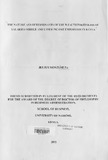| dc.description.abstract | Personal wealth as denoted by accumulated net assets is a key ingredient of a people’s standards of living. This is because wealth facilitates consumption, especially in old age, cushions people against adversities such as illness and unemployment as well as enables further wealth creation through access to bank credit. The assets that comprise wealth include cash and bank balances, properties, shares in cooperatives and listed companies, life assurance policies, accrued pension benefits, corporate bonds, and treasury bills and bonds.
This paper examines the sizes and composition of the wealth portfolios of salaried middle and upper income employees in Kenya in order to find out which personal attributes are key determinants of the portfolios. Primary data was obtained from questionnaires that were administered on a stratified random sample of 1,067 salaried middle and upper income employees in Kenya in mid 2010, the time of survey. The preliminary tests employed the use of Kaiser Mayer-Olkin (KMO) and Bartlett’s Test based on correlation and partial correlation as well as the results of Bartlett’s Test of sphericity to test for the presence of correlations among variables. For this paper, the results KMO measure of sampling adequacy of 0.758 was acceptable, since it was higher than the recommended minimum of 0.50. Additionally, the Bartlett’s Test of sphericity recorded an acceptable p-value of 0.000, which was lower than the test value of 0.05 percent, thereby indicating that there is correlation between the variables. To establish the determinants of the wealth portfolios of employees in Kenya, 21variables
were used. These variables were analyzed using factor analysis procedure and in order to
achieve a simple and meaningful structure, that is, have a nonzero loading of the explained
variance for each individual factors, varimax rotation was done. As a result, six critical
factors were established as the determinants of wealth portfolios of salaried middle and upper
income employees, which include earning capacity, life cycle factors, investment objective,
employee’s cultural background, employees’ risk taking behavior and savings. The findings
largely conform to theory and corroborate evidence from prior studies. | en |

